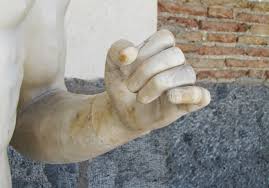Spotlight Artist: Polykleitos
- Jeff Hall
- Mar 9, 2020
- 3 min read
Doryphoros (Spear Bearer)
Roman copy of the bronze original by Polykleitos ca. 450 - 440 BCE (CLASSICAL)
6’ 11” high
Marble
Art Code: "There is value in the work."
Synopsis
The Doryphoros Classical Greek "Spear-Bearer" of Polykleitos is one of the best known Greek sculptures of classical antiquity, depicting a solidly built, muscular, standing warrior, originally bearing a spear balanced on his left shoulder. Rendered somewhat above life-size, the lost bronze original of the work would have been cast circa 440 BCE,[1] but it is today known only from later (mainly Roman period) marble copies. The work nonetheless forms an important early example of both Classical Greek contrapposto and classical realism; as such, the iconic Doryphoros proved highly influential elsewhere in ancient art.
The renowned Greek sculptor Polykleitos designed a sculptural work as a demonstration of his written treatise, entitled the "Kanon" (or Canon, translated as "measure" or "rule"), exemplifying what he considered to be the perfectly harmonious and balanced proportions of the human body in the sculpted form. Polykleitos is known as the best sculptor of men, with the primary subjects of his works being male athletes with idealized body proportions. He was interested in the mathematical proportions of the human form, which led him to write an essay the Kanon, on the proportions of humans. The Doryphoros is an illustration of his writings in Kanon on the symmetria between the body parts. Polykleitos achieved a balance between muscular tensions and relaxation due to the chiastic principle that he relied on. "Scholars agree that Polykleitos based his calculations on a single module, perhaps the terminal section of the little finger, to determine the corresponding measurements of each body part" (MIA Doryphoros Plaque).
The Doryphoros is a marble copy from Pompeii that dates from 120–50 BCE. The original was made out of bronze in about 440 BCE, but is now lost (along with every other bronze sculpture made by a known Greek artist). Neither the original statue nor the treatise have yet been found; it is widely considered that they have not survived from antiquity. Fortunately, several Roman copies in marble—of varying quality and completeness—do survive to convey the essential form of Polykleitos' work.
The sculpture stands at approximately 6.6 feet tall. Polykleitos used distinct proportions when creating this work; for example, the ratio of head to body size is one to seven.
His head turned slightly to the right, the heavily-muscled but athletic figure of the Doryphoros is depicted standing in the instant that he steps forward from a static pose. This posture reflects only the slightest incipient movement, and yet the limbs and torso are shown as fully responsive.
The left hand originally held a long spear; the left shoulder (on which the spear originally rested) is depicted as tensed and therefore slightly raised, with the left arm bent and tensed to maintain the spear's position. The figure's left leg pushes off from behind the right foot; the leg bears no weight and the left hip drops, slightly extending the torso on the left side. The figure's right arm hangs positioned by his side, perhaps held slightly away from the torso for balance, but otherwise bearing no load—the right shoulder is therefore slightly lowered. The figure's right leg is shown as supporting the body's weight, therefore tensed, with the right hip raised and the muscles of the right torso shown as contracted.
The resulting characteristic of Polykleitos' Doryphoros is classical contrapposto, most obviously seen in the angled positioning of the pelvis.
In the surviving Roman marble copies, a large sculpted tree stump is obtrusively added behind one leg of the statue in order to support the weight of the stone; this would not have been present in the original bronze (the tensile strength of the metal would have made this unnecessary). A small strut is also usually present to support the right hand and lower arm.
(excerpt from https://en.wikipedia.org/wiki/Doryphoros)
Gallery
Video
>How Art Made the World Documentary - https://dai.ly/x2pztmx
>Start at 46 minutes.
Essential Questions - Watch the video and read the synopsis prior to answering these questions.
1. Why was bronze used for the original sculpture (of which this example is a copy)? What is problematic about this material and why is it lucky that the Romans were so enamored of Greek art? 2. What is a "canon"? How is the canon of Polykleitos different from the canon used in ancient Egypt (which we explored? 3. Compare and contrast the Doryphoros to last week's Kritios Boy.
4. How does this week's Art Code, "There is value in the work." relate to the process the Greeks took to develop this level of skill?









































Comments